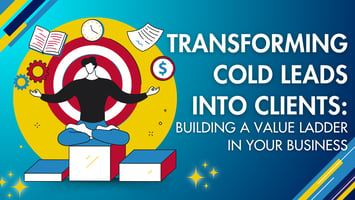Every business owner faces the same challenge: what happens when someone says “no” to your offer?...
Modern IT for Small Business: Avoiding Costly Mistakes & Fortifying Cybersecurity
On a recent episode of The Ownership Advantage, hosts welcomed Gregory and Kimberly Gavin, the dynamic couple behind ByteBak Solutions. With decades of combined experience in IT infrastructure and cybersecurity, they pull back the curtain on the most common—and costly—mistake small business owners make with their technology: refusing to let go of outdated systems.
Many entrepreneurs try to maximize the life of their computers, working on machines that are well past their prime for the sake of saving money. Gregory points out that this frugality often backfires: “When it comes to computers, five to six years is that mark that you really have to move forward. Technology becomes a hindrance, not a help.”
The primary issue? Vulnerability. As Kimberly explains, older platforms stop receiving security updates—think about the end-of-life for Microsoft operating systems. “If you’re holding onto a 10-year-old system, you’re not going to get those security updates, and your business becomes very vulnerable,” she warns.
Why Upgrades Matter: The Lifecycle of Hardware & Software
It’s not just about software. Modern business systems rely on a delicate dance between increasingly powerful hardware and software that pushes boundaries. Gregory illustrates this with a real-world example, explaining how developments like TPM (Trusted Platform Module) chips create new security standards—a necessity for running secure, up-to-date operating systems like Windows 11.
But outdated computers can grind productivity to a halt and leave gaping security holes. And it’s not just PCs: network switches, routers, printers—every device on your network has a shelf life and needs periodic replacement and ongoing patching.
Dividing & Conquering: The ByteBak Team’s Complementary Skills
What sets ByteBak Solutions apart is a blend of Gregory’s expertise in physical infrastructure—firewalls, servers, and networking gear—and Kimberly’s passion for cybersecurity, research, and digital forensics. Kimberly’s journey began as an admin assistant, pivoting to tech after seeing firsthand how devastating cyber theft can be.
Gregory handles the “hardening”—making sure the barriers at the edge of your network are robust. Kimberly digs into the digital underbelly: investigating suspicious emails, scouring phishing attempts, and analyzing threat vectors. Their teamwork ensures both the walls and the windows of your digital “house” are secure.
Training: The First, Best Defense Against Cyber Threats
Even the most resilient technical set-up can be undone by an untrained user. The Gavins emphasize that internal policy and user education are non-negotiable for modern businesses. “Number one thing is to educate your people to tell them about these things,” Gregory stresses.
Simple steps—training staff to recognize urgency tactics, odd sender addresses, spelling mistakes or mismatched URLs—can prevent a costly breach. Regular in-house phishing tests and refreshers help. As Kimberly puts it: “If you have a question, don’t reply to the email. Give that person a call or send them a fresh email.”
The Hardware Dilemma: Choosing What’s Right for Your Business
Should you buy Apple, Dell, Lenovo—or stick with PCs? The Gavins advise against one-size-fits-all answers. Instead, take a tailored approach: understand what your business needs, assess your growth plans, and consult an expert who can match your workflow with the right hardware lifecycle, avoiding costly mismatches or underpowered solutions.
For most companies, the hardware should be cycled every 5-7 years, and always kept up to date with patches and firmware updates.
AI: The Blessing and Potential Curse
Artificial intelligence is transforming how businesses operate and how cyber threats manifest. Kimberly and Gregory see AI as both a research assistant and a new attack vector. AI can make phishing more convincing, automate deepfakes, and intensify malware attacks—but it’s also an incredible tool for quickly gathering information and enhancing defense strategies.
The key? Stay informed and vigilant. As Gregory observes, “AI gives patterns. It’s constantly learning... It has its pluses, it has its minus.”
The ByteBak Philosophy: Partnership and Ownership
Above all, Kimberly and Gregory believe in partnering with clients to understand their unique needs, growth plans, and constraints. “We want to meet your network and guide you,” Gregory says. Their ethos: provide enterprise-level support with small-business empathy—taking pride and ownership in every solution they deliver.
If you’re a small business owner, the takeaways are clear: Don’t neglect upgrades. Invest in training. Seek out tailored advice, not one-size-fits-all fixes. And stay alert—the digital world is always changing.
Connect with Gregory and Kimberly HERE
Check out the full episode on YouTube HERE
Listen to the full episode on Apple Podcasts HERE

.png?height=200&name=Simplifying%20Success%20thumbnail%20(1).png)
